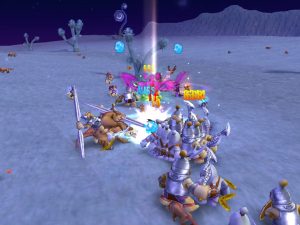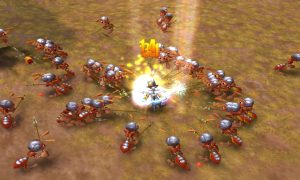Fighting a large enemy force can seem messy and chaotic at first. But if you take time to observe how your enemies attack you and react to the actions of the players, you may notice there is rhyme and reason behind how they approach defenders.
A first important step is being aware of the fact that the M.O.B. will recognize your group’s roles. Although there can be subdivisions within these categories, it can be broadly defined as: Front line, Attackers and Supports.

The M.O.B. will approach these roles in specific ways, and if you (or your group) does not keep this in mind, they may find themselves being overrun in a battle that you could otherwise win. On the other hand, proper knowledge of this can help players direct the flow of battle into a much more controllable pace.
FRONT LINE:
These are your "Tanks", they act as the main buffer between the aggro (main attack targets) of the enemy force and the rest of the players. The front line is mostly composed of Soldier job classes such as Knights and Champions. While there are other classes than can act as members of a front line in times of need; pound for pound, these two are the principal components of it. (Some classes that are in the front line are Clerics with blunt weapons, Dealers with launchers and Hawkers with crossbows). In some instances defensive summons can assist with the front line by luring aggressive enemies onto them.
ATTACKERS:
These are the dedicated damage dealers of the group, while their positions behind the front line can vary based on the average range of their abilities, their overall grouping is of course a safe distance behind the tanks. Classes that typically fill these roles are ones such as Mages, Scouts, Raiders, Bourgeois and Champions. While the front line endures the brunt of the enemy’s attack, the attackers (DPS) whittle down the biggest threats of the opposing force. In some instances offensive summons can assist, by moving in with the tanks to fight and grab enemies onto them.
SUPPORTS:
These are the lifeline of the combat force, typically the healers, buffers and de-buffers of the group. They assist the Front line by keeping it strong and healthy while providing the attackers additional sources of damage so they may thin out the enemy’s numbers. With a few exceptions, these are also typically the members in charge of reviving fallen defenders so that small losses do not add up to ultimate defeat. These are primarily Clerics, though sometimes Mages, Artisans, Raiders and Bourgeois can fill in support roles as well.
The flow of battle can be broken down as follows:
- Front line stands between enemy forces and rest of players.
- Aggro settles in on front line.
- Attackers eliminate enemies, in order of largest to smallest threat.
- Support ensures the tides do not turn on the players.
WHAT CAN HAPPEN?
Rarely do fights follow the above structure perfectly, but there are several things players can do to recover from unexpected events such as a new enemy tactic or a player mistake. Below are some examples and a suggested course of action:
- Melee DPS can pick up spare aggro as they fight alongside the Front line. If they begin to get overwhelmed, ranged DPS may focus on the enemies attacking the melees so they do not fall.
- Supports get targeted. The M.O.B. WILL take opportunities it gets to target a support, if they start to get focused on by the enemy, the Attackers can switch over to protecting the support. **IMPORTANT** Front liners do NOT fall back to aid a support, that will simply cause the enemy aggro to collapse into the player formation.
- Enemies start using abilities such as damaging spells or status effects. Quick assessment of the enemy forces and what they are doing is key. Enemy groups can be comprised of a variety of different enemy types and not all simply walk up to you and attack. Enemies that deal much more damage than the rest, or inflict crippling status effects on the players should take priority in elimination. An example of target priorities is as follows:Enemy units that afflict Sleep or Silence – Top Priority
Enemy leaders with powerful skills and abilities – Secondary Priority
Enemy units that use a surround (aoe) skill - Tertiary Priority
Enemy units that use periodic skills for additional damage – Bottom Priority
Enemy grunts which simply attack their targets – Bottom Priority
*This is meant to be an example, different battles will call for different priorities.
BREAKDOWN, WHAT DO?!
Now that roles are a bit more defined, this is the basis of member’s responsibilities during a fight:
Frontline – Hold a line, stay in between the enemy and your allies. Front liners do not want to leave TOO much space between each other, or else enemies may slip through. Keeping an eye on your armor is imperative as you will be taking a LOT of hits and your armor WILL wear down. Dedicated tanks are recommended to carry around more than one set of armor for extended confrontations.
DPS (Attackers) – Take out enemies in order of priority. Melee DPS such as Champions and Raiders help clear out the enemy front line, prioritizing the stronger targets crashing against the tanks. Ranged DPS such as Mages and Scouts deal with enemies such as bow users and spell casters first, switching then to the enemy front line. Long-range attackers such as Artisans take out high priority targets such as enemies who put players to sleep or wear down large threats before they hit their allied front line.
Supports – They keep the front line healthy, revive fallen allies and provide buffs to those who need it. On the topic of buffs, there are details to keep in mind as to which buffs to use and for what purpose; below is an explanation of the battle utility of some common buffs:
- Attack Buff and Damage Buff: Useful for DPS overall, best used when a large target needs to be taken down.
- Defense Buff, Magic Defense Buff and Dodge Rate Buff: Useful for Front liners, Champions in particular enjoy this buff as their natural defenses are lower than a Knight’s.
- HP Buff: Universally useful buff, it makes the front line more durable and can mean the difference between life and death if a less durable character gets caught off guard.
- Attack Speed Buff: Useful for DPS who are clearing waves of “Grunts” that come in large numbers but get taken down in one hit. Scouts, Artisans and Bourgeois can be said to benefit more than others but anyone clearing out waves of enemies will benefit from this buff (even the Tanks).
- Movement Speed Buff: While movement speed is great for travelling around the map and scouting objectives. DURING COMBAT, movement speed buffs are far less useful. The front line and melee DPS will not be doing a lot of moving and the ranged attackers, while slightly more free to move around, do not want to move PAST the front line. It is wise to avoid using this buff once the enemy has engaged, for a second spent casting this buff is one not spent casting a more useful one or healing an ally. Typically, classes that can scout or kite larger enemies around can provide themselves with excellent speed buffs, so as a support have this buff low on your priority list.
- Critical Hit Buff: A large enough chance to land a critical hit is a sizable steroid to auto-attacks, however some classes (and players) tend to focus on skill usage over weapon swings / shots for their main damage output. Unless you know the target of your buff will be auto-attacking a fair amount (other than one-shooting enemy grunts), you should stray away from using this buff.
A support also must work between priorities, if both a DPS and a member of the front line is in trouble, the priority should go to helping the front liner, ensuring the formation holds. Sometimes players will expect too much out of a support, it is important to know what your priorities are and stick to them, ensuring victory.

CLOSING THOUGHTS
Practice makes perfect. Experiment with Front line formations, methods of recovery, ways to adjust to events. Fighting often with the same group of people can also develop a stronger sense of communication between the players; your own battalion is a great place to start! Try things out, see what works and what doesn’t, and learn the tactics your enemies use against you (different factions have different fighting styles, keep that in mind!). Best of luck out there, and may you hold on to your "exp".
